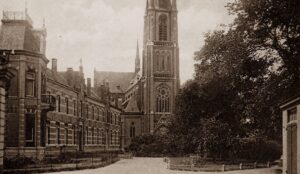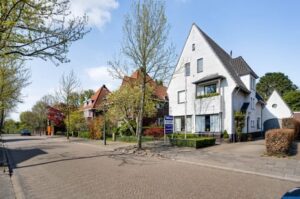Aarts, Johannes Theodorus, born on 07-04-1899, in Asten,  Netherland. Jan married Maria van der Heijden, with whom he had six children. When Maria died prematurely, he married Tonia Koolen, with whom he had another son. However, Tonia was a mother to all the children, and together they formed a close-knit family. When the war breaks out, Jan lives in my hometown Eindhoven on Wolvendijk
Netherland. Jan married Maria van der Heijden, with whom he had six children. When Maria died prematurely, he married Tonia Koolen, with whom he had another son. However, Tonia was a mother to all the children, and together they formed a close-knit family. When the war breaks out, Jan lives in my hometown Eindhoven on Wolvendijk  and works as a foreman in the Philips light bulb factory.
and works as a foreman in the Philips light bulb factory.  Jan has an active, optimistic character and is very patriotic. During the German occupation, Jan plays an active role in the resistance. At home, he kept a radio hidden under the sofa, which he used to listen to Radio Oranje.
Jan has an active, optimistic character and is very patriotic. During the German occupation, Jan plays an active role in the resistance. At home, he kept a radio hidden under the sofa, which he used to listen to Radio Oranje.  Because there was a shortage of almost everything during the war, Jan grew his own corn, potatoes, and vegetables in his garden; he used the motor from his washing machine to grind the corn. On 18-09-1944, Eindhoven was liberated.
Because there was a shortage of almost everything during the war, Jan grew his own corn, potatoes, and vegetables in his garden; he used the motor from his washing machine to grind the corn. On 18-09-1944, Eindhoven was liberated.  The next morning, Jan is visited by a Mr. Van Vechel, an official of the Dutch army,
The next morning, Jan is visited by a Mr. Van Vechel, an official of the Dutch army,  who persuades Jan to enlist. Jan, driven as he is, immediately agrees and leaves with his family in the afternoon for the registration office at the station. Because he will be staying there overnight, he asks his children if they can bring food from home.
who persuades Jan to enlist. Jan, driven as he is, immediately agrees and leaves with his family in the afternoon for the registration office at the station. Because he will be staying there overnight, he asks his children if they can bring food from home.
After his son Harrie brings his father sandwiches and potato pancakes, Jan urges him to hurry back home because the Germans have announced a bombing raid. “And tell them I’m coming too,” he adds. When the bombing starts, Harrie is still in Antoon Philips’ garden when he has to take shelter. With shrapnel flying around him, he jumps back on his bike and returns home. Despite all the warnings, Jan also decides not to wait out the bombing in the station basement. Together with his neighbor Jan Sleddens, they walk home along the railway siding. When the bombing erupts in full force, they dive into a ditch. There, Jan is killed instantly by a direct hit. Jan Sleddens is seriously injured. The station they had left in the expectation that it would be safer elsewhere was not hit in the bombing. His family waits all night for Jan to return. When they see the red glow above the city from their living room, they fear that Jan will not come out of there alive. Later that day, after a fruitless search of hospitals and temporary hospitals, the pastor comes to their home to tell them that Jan died on 19-09-1944, one of the 277 Eindhoven residents who died in the bombing, was 45 years old and found his final resting place at the National War Cemetery in Loenen. , Groenendaalseweg 64, 7371 EZ Loenen. Grave 346.
On September 19, 1944, my hometown Eindhoven was initially still celebrating. The city had been liberated the day before, and residents lined the streets to welcome their liberators. But by mid-afternoon, the mood had changed. Rumors spread that the Germans were advancing again from Nuenen and Helmond.
The occupying Nazi pilots previously stationed at the military airport Fliegerhorst  in Eindhoven had been withdrawn to Osnabrück in Germany, but because of their knowledge of the surroundings were sent back to the area on the of 19 September 1944, to bomb Eindhoven. On that evening, at ten after seven, they dropped flares and 76 aircraft’s, Junkers-88 en Dorniers-217 of the Kampgeschwader 2, 30 en 66 and Lehrgeschwader 1, part of the IX Fliegerkorps under command of Oberstleutnant Rudolf Hallensleben
in Eindhoven had been withdrawn to Osnabrück in Germany, but because of their knowledge of the surroundings were sent back to the area on the of 19 September 1944, to bomb Eindhoven. On that evening, at ten after seven, they dropped flares and 76 aircraft’s, Junkers-88 en Dorniers-217 of the Kampgeschwader 2, 30 en 66 and Lehrgeschwader 1, part of the IX Fliegerkorps under command of Oberstleutnant Rudolf Hallensleben  , attacked unnoticed Eindhoven. Rudolf Hallensleben, later was killed in battle 19-04-1945 (near Leipheim/Bavaria), Luftwaffe aircraft prepared for the planned air raid by dropping flares,
, attacked unnoticed Eindhoven. Rudolf Hallensleben, later was killed in battle 19-04-1945 (near Leipheim/Bavaria), Luftwaffe aircraft prepared for the planned air raid by dropping flares,  which some people mistaken for celebratory fireworks. Their targets were the British army corps’ transit routes: Aalsterweg, Stratumsedijk, Stratumseind, Rechtestraat, Wal, Emmasingel, Hertogstraat, and the surrounding area. The British vehicles were trapped. Vehicles loaded with ammunition and fuel exploded. Large fires broke out everywhere. The number of civilian casualties was enormous. In the street Biesterweg nr 56 where the webmaster is born, 41 people were killed when the shelter in the open field where they were hiding, was hit.
which some people mistaken for celebratory fireworks. Their targets were the British army corps’ transit routes: Aalsterweg, Stratumsedijk, Stratumseind, Rechtestraat, Wal, Emmasingel, Hertogstraat, and the surrounding area. The British vehicles were trapped. Vehicles loaded with ammunition and fuel exploded. Large fires broke out everywhere. The number of civilian casualties was enormous. In the street Biesterweg nr 56 where the webmaster is born, 41 people were killed when the shelter in the open field where they were hiding, was hit.  The only house hit by a bomb in the street was Nr 56,
The only house hit by a bomb in the street was Nr 56, 
 but my parents, then with 4 children,
but my parents, then with 4 children,  had left the house 15 minutes before.
had left the house 15 minutes before.

















Leave a Reply